The Straits Times marks 178 years as region’s oldest newspaper
Sign up now: Get ST's newsletters delivered to your inbox
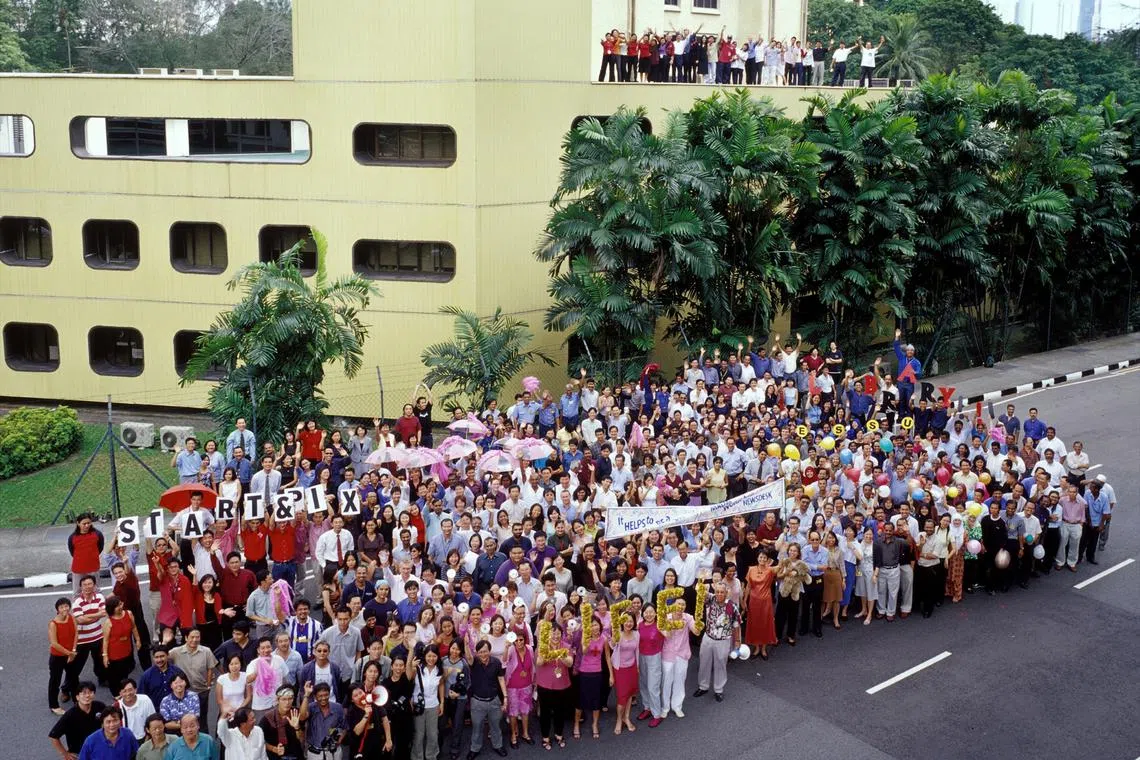
Times House staff gather for a final group photo at Kim Seng Road.
PHOTO: ST FILE
Follow topic:
SINGAPORE – Exactly 178 years ago on Saturday (July 15), a local newspaper was accidentally started by a wealthy businessman named Catchick Moses, who stepped in to help a fellow Armenian who had ordered a printing machine but ran into financial trouble.
The eight-page English language weekly, initially called The Straits Times and Journal of Commerce (ST), was aimed at a small but growing European population in Singapore hungry for news about home, as well as updates on the steady stream of sailing ships in the port city and prices of commodities.
Its first editor, 29-year-old British journalist Robert Carr Woods, almost single-handedly provided the content for the paper, which was produced using a hand-operated press in a rented office at 7 Commercial Square, in what is now Raffles Place.
Mr Woods kept his nose to the ground to craft stories that made the headlines, such as news about the changing socio-political landscape in Singapore since its founding as a free port in 1819 by Sir Stamford Raffles.
He wanted ST to be more than just a businessman’s bulletin or a gazette for the colonial government, focusing instead on well-crafted news one could use.
ST was the third player in the island’s fledgling newspaper business. In 1824, The Singapore Chronicle – Singapore’s first newspaper – was started by publisher and editor Francis James Bernard, the son-in-law of the first Resident, William Farquhar, just five years after Singapore gained its status as an entrepot hub.
But the Chronicle went belly-up in 1837 after Singapore’s second newspaper, The Singapore Free Press and Mercantile Advertiser, hit the stands on Oct 8, 1835. After the Japanese Occupation, the Free Press was bought over by ST in 1946.
From 1845, ST and the Free Press were weekly papers, with ST appearing on Tuesday mornings and the Free Press on Thursdays.
The two papers catered to a readership of 336 European men, women and children in 1845, which grew slightly to 360 at the end of the decade. It was only in 1858 that ST became an afternoon daily, briefly changing its name to The Daily Times, but reverting to The Straits Times in 1883.
When the colonial government dragged its feet on tackling secret-society violence, as well as providing public schools and hospitals, ST took issue.
Mr Woods wrote in one of his earliest no-holds-barred editorials: “Poverty is stalking through our streets, and in the purlieus of the Town, where the haunts of vice, indigence and disease are unobserved by the European part of the community. Many are dying daily for lack of labour and food.”
Mr Woods sold ST in 1861 to Mr John Cameron, a 26-year-old mariner. When Mr Cameron died in 1881 at the age of 46, he passed the press on to his widow. During Mr Cameron’s short tenure as editor-proprietor, however, he saw ST’s fortunes improve further.
Growing with Singapore’s success
In 1869, the opening of the Suez Canal saw sailboats give way to giant steamships. This made Singapore one of the most important ports in the lucrative maritime highway from Europe to the East.
It also resulted in a sudden spike in trade, with total trade volume hitting $71 million in 1870 – a year after the canal was opened – up from $39 million in 1869.
According to the late historian Mary Turnbull, who wrote Dateline Singapore: 150 Years Of The Straits Times in 1995, regular steamship services through the Suez meant faster delivery of mail and newspapers, and cheaper travel for the masses.

Issue featuring report on the Japanese surrender on Sept 13,1945.
PHOTO: THE STRAITS TIMES
In March 1870, the first ocean cable linking Bombay with Britain was laid through the Suez Canal. That year, ST subscribed to Reuters news agency for “cable” news, becoming the region’s only newspaper at the time to carry foreign news.
ST has survived two world wars, gone through political upheavals that saw major changes in nationality and leadership, and navigated disruptive technologies such as the television and Internet – and, more recently, weathered a crippling pandemic.
Dubbed the “grand dame”, it is South-east Asia’s oldest surviving newspaper.
Younger extant papers include The Malay Mail, which was started in 1896 and is now fully digital, The Manila Times (1898) and the South China Morning Post (1903).
There is also a special archival selection of ST’s coverage of defining moments in Singapore’s history, which is preserved in the National Heritage Board’s National Collection.
The collection tells of the nation’s history, shows its links with ancestral civilisations and the region, charts its journeys and documents its success. It also gives tangible evidence of the Republic’s rich multicultural heritage as a trading centre and creative hub.
“This includes the first issue of ST printed at the end of the Japanese Occupation of Singapore,” says a spokesman for NHB.
“Some of ST’s prominent headlines relating to Singapore’s merger and separation are also featured in the National Museum of Singapore’s Singapore History Gallery.”
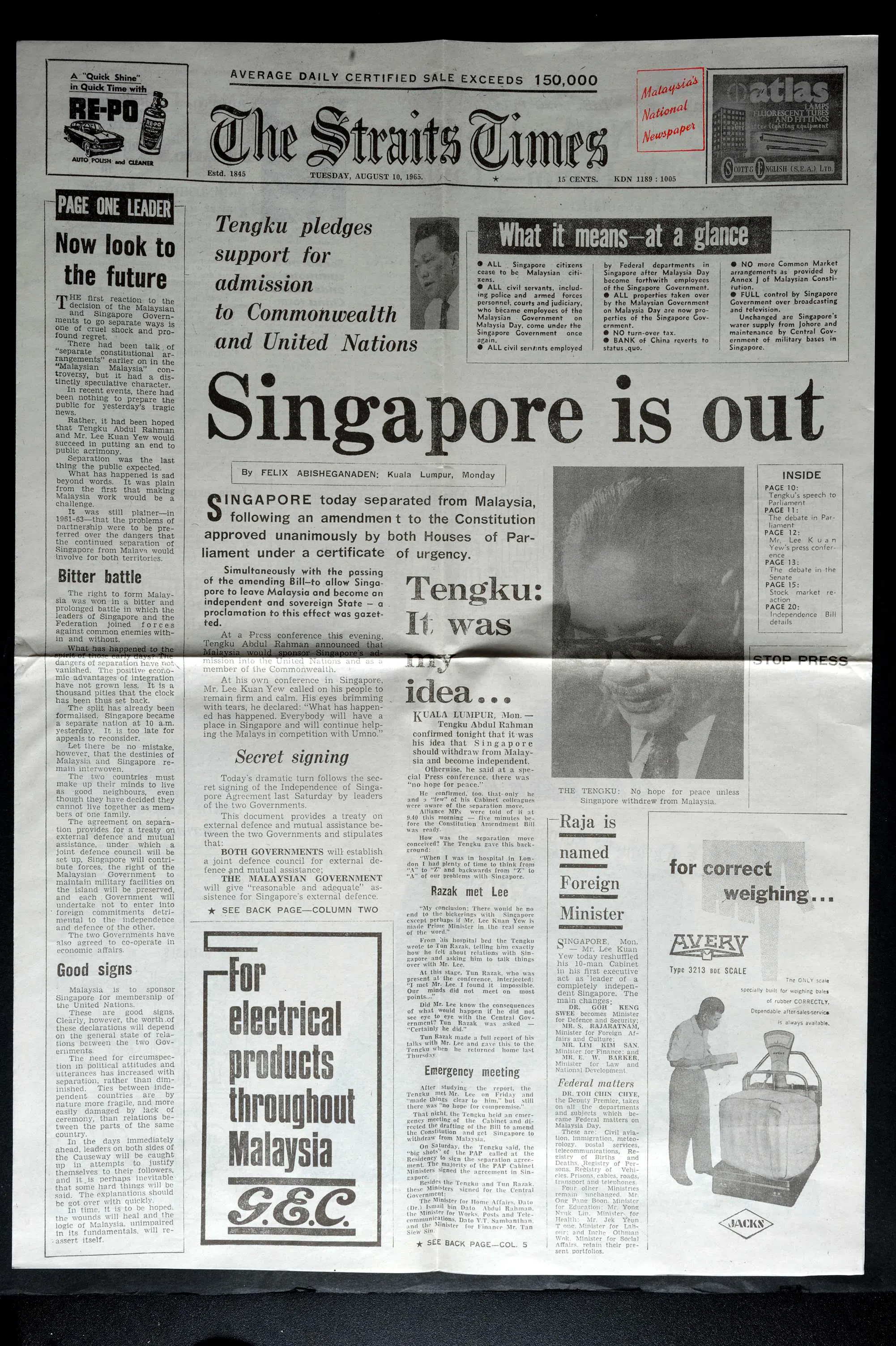
“Singapore is out (of Malaysian federation)“ published on Aug 10, 1965.
PHOTO: THE STRAITS TIMES
The key to newspapers’ success is in telling the story of cities, says Dr Mario Garcia, veteran newspaper and magazine designer, as well as adjunct professor at the Columbia University Graduate School of Journalism in New York, in the United States.
“To some, newspapers, especially print editions, are like artefacts from another era,” adds the 76-year-old, who has redesigned 764 newspapers in 122 countries, including Singapore. He visited the Republic in June for a series of talks on news design for a digital era.
Also part of the city’s legacy are newspaper buildings, many of which have disappeared throughout the world.
“The buildings in the downtown area were viewed by people as urban landmarks and, in many countries, the pages of the printed newspaper would be displayed behind glass for people to stop by and read,” says Dr Garcia.
“Newspapers brought a certain richness, impact and influence to their cities, and are a sort of diary of daily occurrences. Before Facebook, Instagram and TikTok, there were newspapers.”
Dr Garcia says fewer people read in print today, as they prefer to consume the news on iPads, computers and, primarily, their smartphones.
He adds that about 82 per cent of the world’s population gets news and information via their phones, with the average person picking up his or her phone 114 times a day.
“But the brands remain powerful beacons of a country’s and a community’s history,” he says.
“For that reason, newspapers will always be important, regardless of the platform in which people consume them.”
While ST is housed today in SPH News Centre in Toa Payoh North – a building which was completed in 2002 and designed by home-grown architectural practice DP Architects (DPA) – the paper has also contributed to Singapore’s architectural heritage. In the last century, it had two previous office buildings which are now no more.
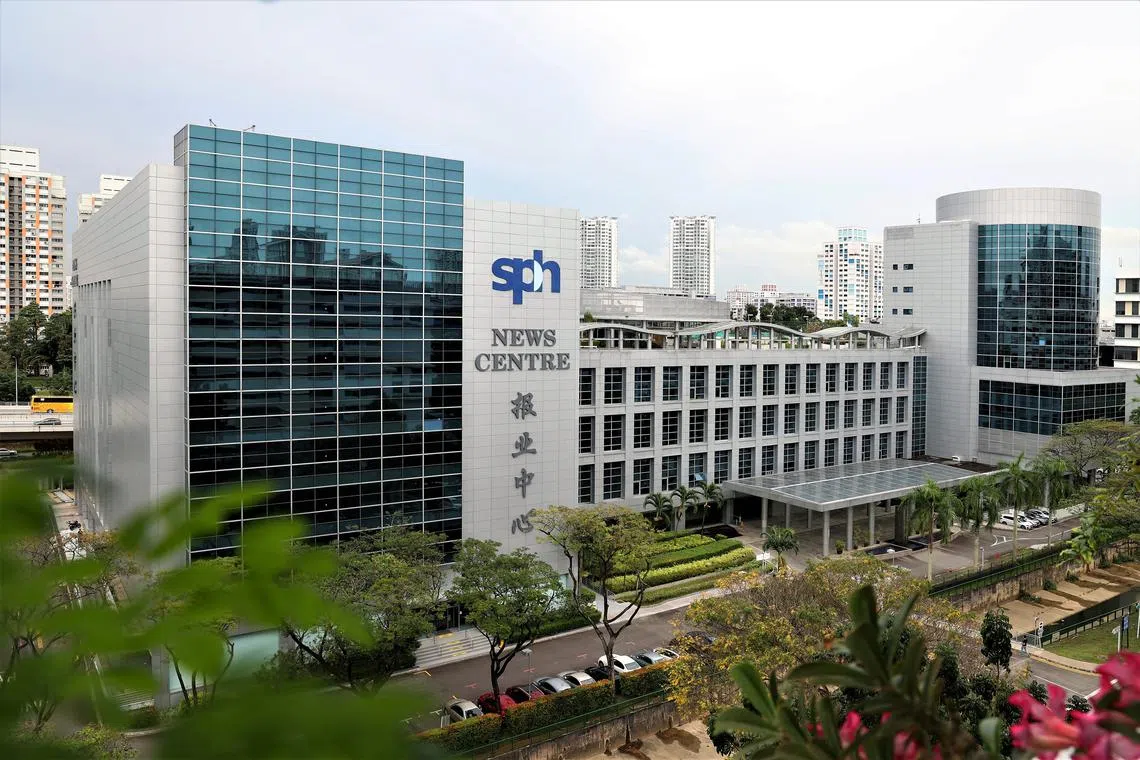
Straits Times is housed today in SPH News Centre in Toa Payoh North.
PHOTO: ZB FILE
Singapore-based architectural historian Julian Davison says both the buildings that ST commissioned from Swan & MacLaren – in Cecil Street and Kim Seng Road – were cutting-edge structures at the time, showcasing the latest building technologies.
The 1903 building in Cecil Street, designed by English architect Regent Alfred John Bidwell, was reinforced by a steel frame to carry the weight of heavy machinery such as the printing press.
Though there were other brick-built buildings reinforced by steel frames during that period – such as Stamford House, which was also designed by Bidwell in 1903 – the Cecil Street design was advanced for its time.
“But the really cutting-edge building is the 1933 one (an extension of the 1903 building) designed by Doucham Slobodan Petrovitch, one of Singapore’s pioneer Modernist architects,” says Dr Davison, 67.
“He had trained at the Architectural Association In London and arrived in Singapore around 1927, bringing the latest ideas and building technologies with him – steel frame, reinforced concrete, slab floors, metal-frame windows and Shanghai plaster finishes – which he used to good effect.”
ST was so impressed with the Cecil Street building that it was featured in a full-page advertorial with various supplementary articles on Oct 10, 1933.
In 1958, Swan & MacLaren completed the fully air-conditioned Times House building with its mustard-hued facade in Kim Seng Road, commissioned three years earlier.
It housed ST’s English- and Malay-language press for about 44 years. Times House saw the evolution of the publishing industry in Singapore, which moved away from hot metal typeset printing to computerised typesetting, ridding the air of toxic melted lead used in antiquated processes.
For the first time in Singapore’s history, the building was also home to a growing number of Singaporean and Asian writers, such as late Singapore president Wee Kim Wee and former ST editor Sit Yin Fong.
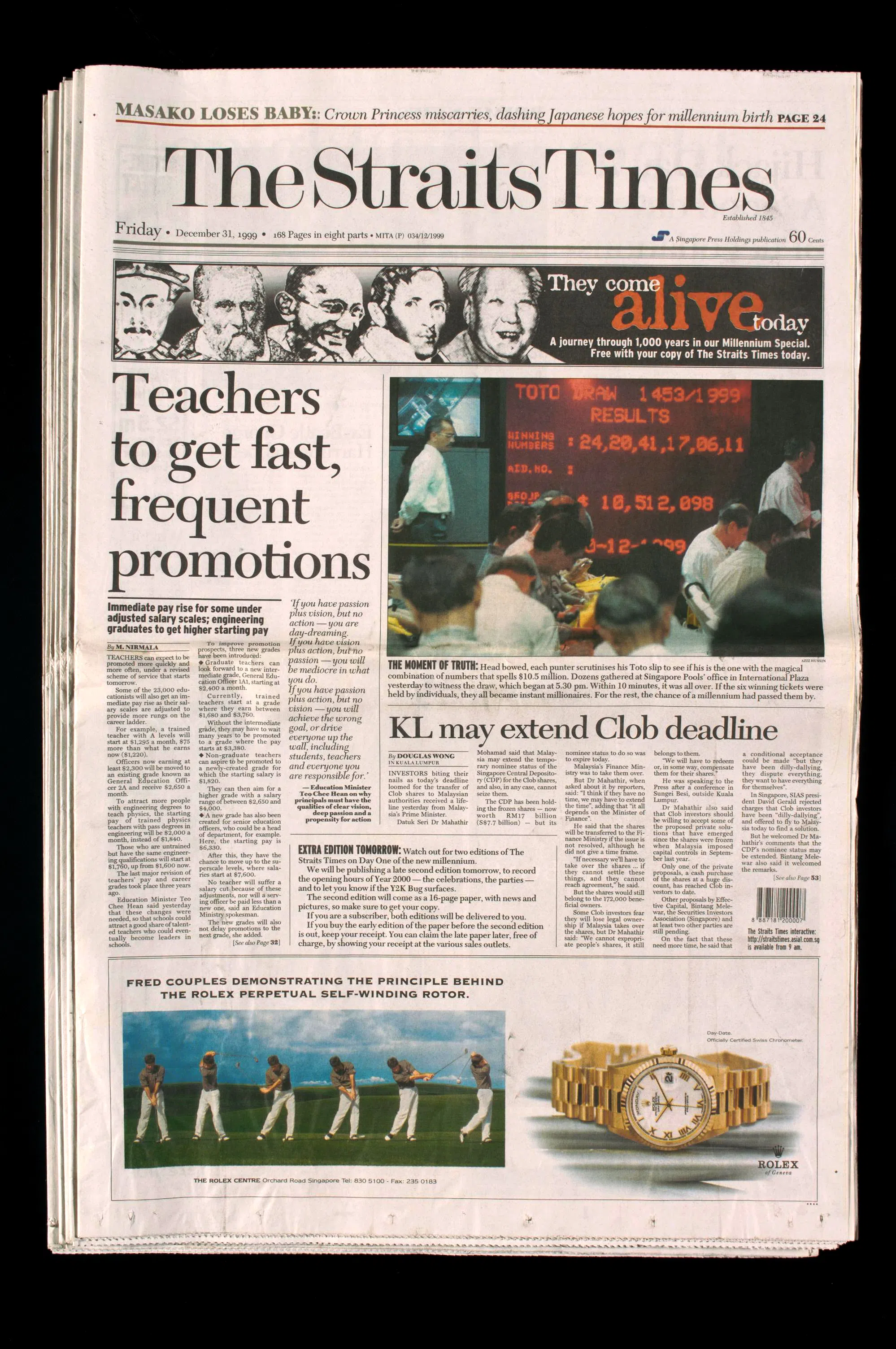
The “last ST issue of the 20th century”, published on Dec 31, 1999.
PHOTO: THE STRAITS TIMES
Mr Wee’s seminal 1966 newspaper interview with General Suharto, in which the Indonesian leader said he wanted to end hostilities with Singapore and Malaysia and make peace, made headlines around the world.
Mr Sit, known as the “scoop king” for his local crime stories, became the first Asian news editor in Singapore and British Malaya in 1954. In the 1800s and early 1900s, mainly British writers had ruled the roost.
In June 2023, 16 current and former editors and journalists celebrated the launch of Once Upon A Time In Times House, a collection of reminiscences about working in the Kim Seng Road office where ST, The Business Times, Berita Harian and the now-defunct New Nation had their editorial offices.
After a merger of three organisations – The Straits Times Press Group, Singapore News and Publications Limited and Times Publishing Berhad – in 1984, Singapore Press Holdings (SPH) was formed.
On Feb 12, 2002, 371 members of staff moved from Times House to the 54,000 sq m SPH News Centre in Toa Payoh North.
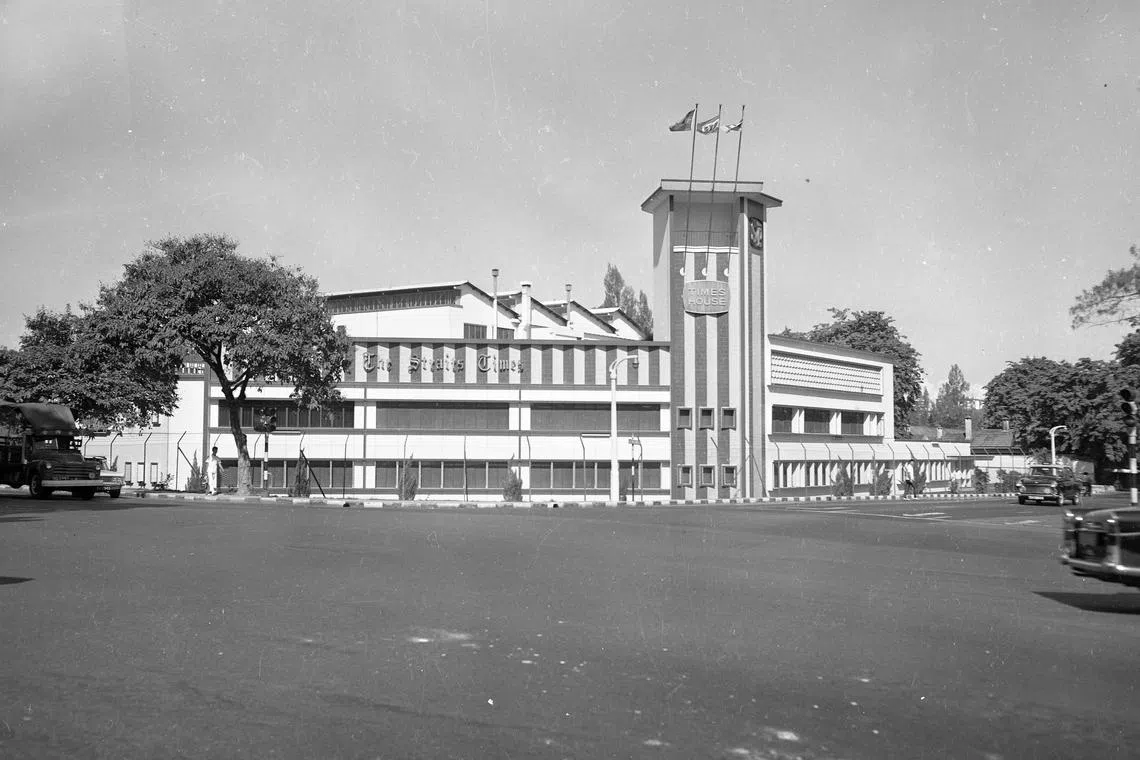
Times House at 390, Kim Seng Road, on July 13, 1970.
PHOTO: ST FILE
Designed by a DPA team led by Mr Ti Lian Seng, the sprawling new nerve centre for SPH was conceived with a focus on working life in the new millennium.
“The new SPH headquarters was designed to provide more than 2,000 people with a conducive atmosphere for the creative practices of the press to flourish,” says Mr Ti.
Since Dec 1, 2021, ST has been part of SPH Media Trust (SMT), a new company limited by guarantee. ST and its sister titles in English, Malay, Tamil and Chinese – previously owned by Singapore Press Holdings – come under a new entity called SPH Media, a part of SMT. SPH Media currently prints 15 newspapers.
The formation of SMT is the most significant change in the local media landscape since the 1984 merger which resulted in the formation of SPH.
While ST is now available on smartphones, tablets, apps and social media feeds, some still prefer the old-fashioned, tactile way of getting their daily news fix.
Madam Terry Chia, a creative director in a local company, remembers having The Straits Times in her home since she was a child.
“I remember my father reading The Straits Times every morning at breakfast, and somehow I have also picked up the habit,” says the 71-year-old, who has a 43-year-old daughter and four-year-old granddaughter.
“I’m not sure if it has anything to do with age, but I still prefer the physical newspaper to the digital version. Munching on my curry puff during breakfast is not the same without a newspaper to read.”
Singaporean entrepreneur Bhagwan K. Assudani, who imports trendy apparel from cities across India, says ST is part of a morning ritual that dates back to the early 1950s, when his parents moved to Singapore from Hyderabad in northern India’s Sindh province.
“Growing up in a walk-up apartment in Tembeling Road, I remember how my father would always sit at the balcony with piping hot milk tea and The Straits Times in the early morning hours,” says Mr Assudani, who lives in a terraced house in East Coast Road with his wife and their three children.

Singaporean entrepreneur Bhagwan K. Assudani says ST is part of a morning ritual that dates back to the early 1950s.
ST PHOTO: JASON QUAH
In the old days, he says Indian vendors on bicycles were “skilled marksmen” who could lob a tightly rolled-up newspaper into the balcony of his father’s apartment.
Today, the 70-year-old carries on his father’s morning ritual, spending up to two hours from 7am reading ST from cover to cover with his morning tea.
“My favourite parts of the paper are local and world news, stock market indices, and cartoons by local artists.”
Mr Assudani adds that he also gets his helper to stockpile back issues of the paper when he travels, so he can catch up on local news when he returns.
“I am lost without The Straits Times as it is an integral part of my day.”
For editor-in-chief Wong Wei Kong, his strongest impression of ST was as a young boy in 1975 seeing photos of the fall of Saigon and the end of the Vietnam War on the cover.
“I still remember the Page 1 story and pictures,” recalls the 55-year-old, the former editor of ST’s sister publication, The Business Times.
“I remember my parents looking very worried when I asked them about it. It sparked my interest in history, and ST was where I immersed myself in the stories that were breaking out all over the world at a time when there were few additional sources of information,” says Mr Wong, who became editor-in-chief of SMT’s English, Malay, Tamil Media group in October 2022.

Changing masthead designs for The Straits Times since 1845.
PHOTO: THE STRAITS TIMES
He says that newspapers with a long history that chronicle their communities and the larger world carry with them a great sense of heritage, but that is not enough.
“ST is no different, having told the Singapore story through different periods of tremendous change. But while it is important to recognise that, and to know where we came from, it does not confer on us any right to exist regardless,” he adds.
“Great newspapers die too, and that is a reminder that while ST has a great heritage, it means something only if we continue to stay relevant, and carve out for ourselves a role in the future.”
Singapore’s earliest newspapers
Asian merchants and Europeans in 19th-century Singapore relied on newspapers to keep tabs on arriving and departing ships. The timely movement of people, goods and mail was key to the success of enterprises, as well as the safe passage of travellers to and from the port city.
Here are the earliest newspapers which helped shape how The Straits Times crafted its content.
1) The Singapore Chronicle
Singapore’s first broadsheet was published on Jan 1, 1824, by Mr Francis James Bernard, the Assistant in the Police Department and son-in-law of Singapore’s first British Resident, William Farquhar.
The two men applied to the colonial government to publish a commercial newspaper.
Mr Bernard’s newspaper concept was supported by Mr John Crawfurd, Mr Farquhar’s successor as the Resident. The men believed the newspaper, published fortnightly on Thursdays, would contribute to the respectability of Singapore.
On Jan 6, 1831, the paper was renamed The Singapore Chronicle and Commercial Register, with its first issue printed on Jan 6, 1831.
Its annual subscription rate was 18 Spanish dollars while single copies were sold at 50 cents each. From January 1835, it was printed on Saturdays.
The Singapore Chronicle was the only Singapore newspaper till 1835 when The Singapore Free Press rolled off the presses. In 1837, The Singapore Chronicle ceased publication.
2) The Singapore Free Press
The island’s second newspaper, The Singapore Free Press, put out its first issue on Oct 8, 1835.
It was founded by Mr William Napier, a lawyer; Mr George D. Coleman, the first Superintendent of Public Works; Mr Edward Boustead, founder of trading house Boustead and Co.; and Mr Walter Scott Lorrain, head of trading house Lorrain, Sandilands and Co.
It was named The Singapore Free Press to mark the end of a period of press censorship in 1835. Prior to that, legislation forbade press criticisms of the East India Company, the local government and its policies. Every issue of a publication was vetted by government officials before it could be published.
The paper remained in circulation until 1869 and was revived in 1884 by Mr Charles Burton Buckley, who later wrote the classic book, An Anecdotal History Of Old Times In Singapore 1819-1867.
In 1932, ST published a morning paper, The Singapore Daily News, to compete with the Free Press. It acquired the Free Press the following year.
After World War II, ST revived the Free Press on May 15, 1946, as a daily.
The last issue of The Singapore Free Press was published on Feb 28, 1962, before it merged with The Malay Mail, a Kuala Lumpur-based paper first issued on Dec 14, 1896, and which was bought by Straits Times Press in 1952.
The paper retained the name The Malay Mail and was called the “national afternoon paper of Malaya and Singapore”.
In early 1959, prior to going into voluntary liquidation in Kuala Lumpur, the Straits Times Press transferred its business to Malay Mail Press Co Ltd.
After 1965, when Singapore and Malaysia separated, an agreement was reached for the Malaysian part of the paper to be Malaysian-owned.
The Malay Mail is currently a fully digital platform owned by Malay Mail Sdn Bhd.
3) The Malaya Tribune
The Malaya Tribune was the first English-language daily newspaper in Singapore aimed at an Asian readership.
It started as an afternoon newspaper in Singapore on Jan 1, 1914. By the 1920s, it was distributed across Singapore, Malaya, Siam, Java, Sumatra and Borneo.
It was managed by a limited liability company and its board of directors included Dr Lim Boon Keng, a doctor trained in Edinburgh who was one of the first Queen’s Scholars in Singapore.
The Malaya Tribune Press expanded in the 1930s, creating a chain of newspapers such as The Sunday Tribune, the Morning Tribune, and local editions for Kuala Lumpur, Ipoh and Penang.
At the height of its circulation, The Malaya Tribune was the largest daily newspaper in Malaya. After the Japanese Occupation, it suffered damage to its equipment and incurred heavy losses due to post-war spikes in the prices of raw materials. It published its last issue on Jan 31, 1951.


